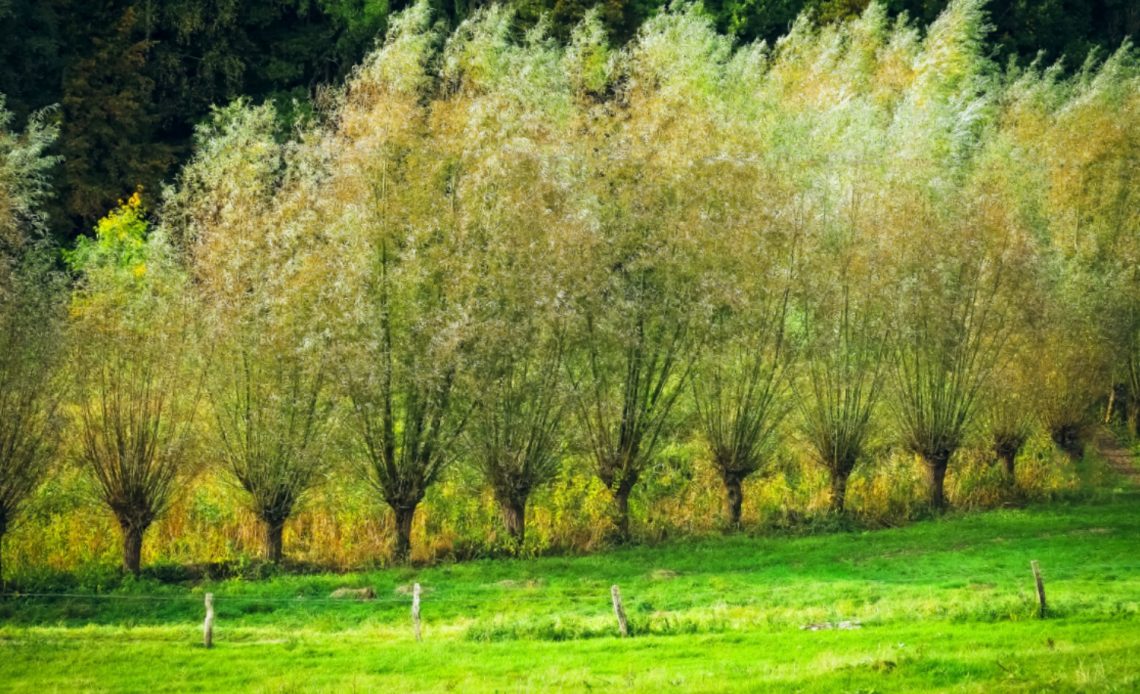

We’re here to help! Wild Yards is a completely free website that is 100% dedicated to helping you create a wildlife-friendly, sustainable yard. Read more
WildYards is reader-supported. When you buy a product through a link on our site, we may earn a comission. Every product is independently selected by our (obsessive) editors and our reviews are unbiased and objective. Read more about our mission or our privacy policy.
You may like your neighbors. You may even love your neighbors. But other people can’t really compete with your own personal privacy, can they? Sometimes it’s nice to step outside on your porch in the morning, wearing your pajamas, and sipping a cup of coffee. Unfortunately, the fear of being seen by someone you know sends you scrambling back inside. If you want to put a barrier between you and your neighbors, look to these cheap fast growing privacy trees for help.
North Privet, Thuja Green Giant, and Leyland Cypress trees provide you with a year-round privacy hedge. Bamboo and Austree Willow Hybrids are best for yards that stay wet, while Spartan Junipers and Red Maples are incredibly drought-tolerant.
What are the best fast-growing trees for privacy screens?
There is no one-size-fits-all privacy tree solution. Each yard has its own unique soil and sunlight profile. To determine which of the following cheap fast growing privacy trees is right for you, first assess the light conditions of the location and test the soil, so you have a better understanding of its pH and moisture retention capacity.
Another important thing to consider is space. For limited areas, make use of shorter shrub trees that pack together tightly. For unrestricted spaces, go for the big trees that spread out wide. If you live in a shady region, opt for deciduous privacy trees that lose their leaves in winter and allow the sun’s warming rays to reach your home. If you live in an open, sunny location, then evergreens may be more appropriate.
Keep these factors in mind when choosing the right privacy trees for your property.
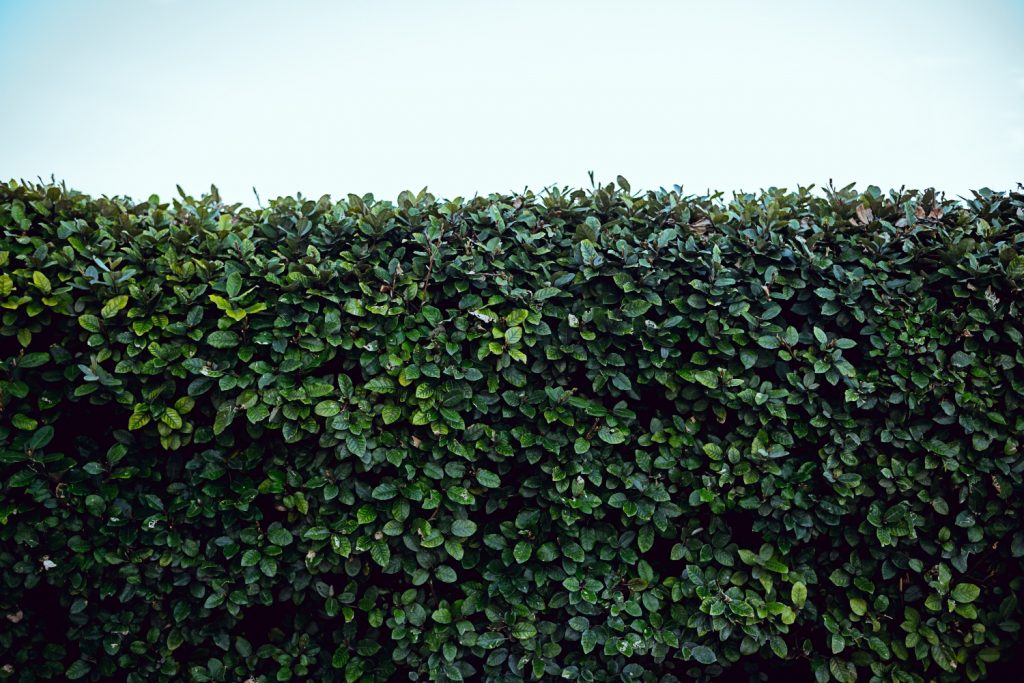
Austree Hybrid Willow (zones 4 through 9)
Austrees hybrid willows are the ideal choice for backyards that sit underwater for long periods of time. The soil surrounding young trees must be kept moist, otherwise, the plants will die. Austrees grow best when planted in full sun to partial shade in slightly acidic to slightly alkaline soil.
Though some sources claim Austrees can live for upwards of 50 years, the average lifespan is actually around 30 years. Many people grow Austrees in tandem with more slow-growing trees like oaks and beeches to provide fast shade while these hardwoods mature. Austrees reach maximum heights of 50 to 75 feet, with a spread of 30 feet. Their dense, pliable foliage means they make excellent windbreaks, as well as privacy screens.
Plant Austree hybrids 8 feet apart to create a barrier between your property and the prying eyes of your neighbors. Because willow trees have incredibly invasive root systems, it’s best to plant them at least 50 feet away from any buildings, septic tanks, or water pipes. The roots of a willow tree can cause thousands of dollars of damage if planted too close to these structures.
Spartan Juniper (zones 4 through 9)
This narrow hybrid Chinese juniper is tall and slender, a popular choice for use in many modern landscapes thanks to its elegant profile. But this tree is no one-trick pony. It can be used to create a privacy hedge, too. Spartan junipers average 15 feet tall by 5 feet wide, and their thick bristly foliage packs together nicely, making a natural privacy fence that stays green all year long.
Although Spartan juniper trees need to be watered often when first planted, they’re extremely drought-tolerant once established and thrive in full sun. These junipers need well-drained soil to grow well. Keeping them in overly moist soil results in root rot, so be sure to amend your soil ahead of time so you don’t wind up wasting money on your privacy tree investment.
Plant Spartan juniper trees 3 to 5 feet apart, closer for a denser privacy screen, farther if you want a little air to circulate in between the branches. Spartan juniper trees grow about a foot a year, and, although they do best in the ground, they can also be planted in pots and arranged on patios. They’re the perfect tree for greening up your backyard in the winter.
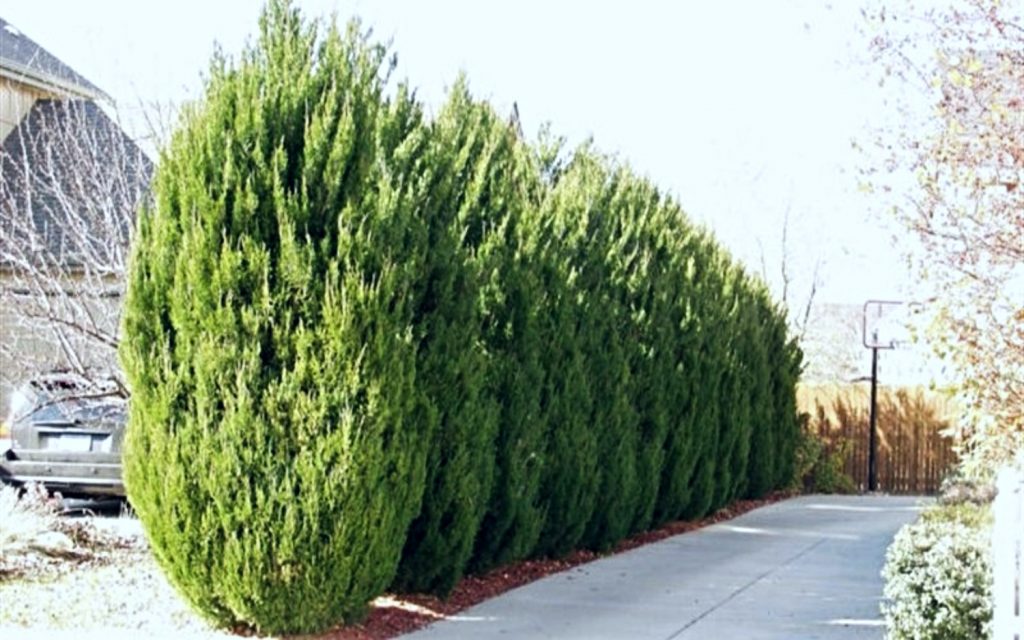
Thundercloud Plum Tree (zones 5 through 8)
The Thundercloud plum tree is mostly grown as an ornamental. In spring, its abundance of beautiful pink flowers attracts bees and other pollinating insects. But the tree’s deep purple-red fruits are perfect for homemade jams and jellies. Songbirds like to feed on them, too.
Thundercloud plum trees measure 15 to 30 feet tall at maturity by as many feet wide and typically grow 2 feet a year. Unlike some trees, the Thundercloud plum tree is tolerant of moderate clay content, preferring somewhat sandy well-draining loams. These trees are accepting of a range of soil types, including acidic, neutral, and alkaline.
Young trees should be watered regularly during the first year. It takes 3 or 4 years before they begin producing fruit. To encourage your Thundercloud plums to grow as quickly as possible, avoid overwatering them once they’ve become well-established, as these trees hate sitting in mud.
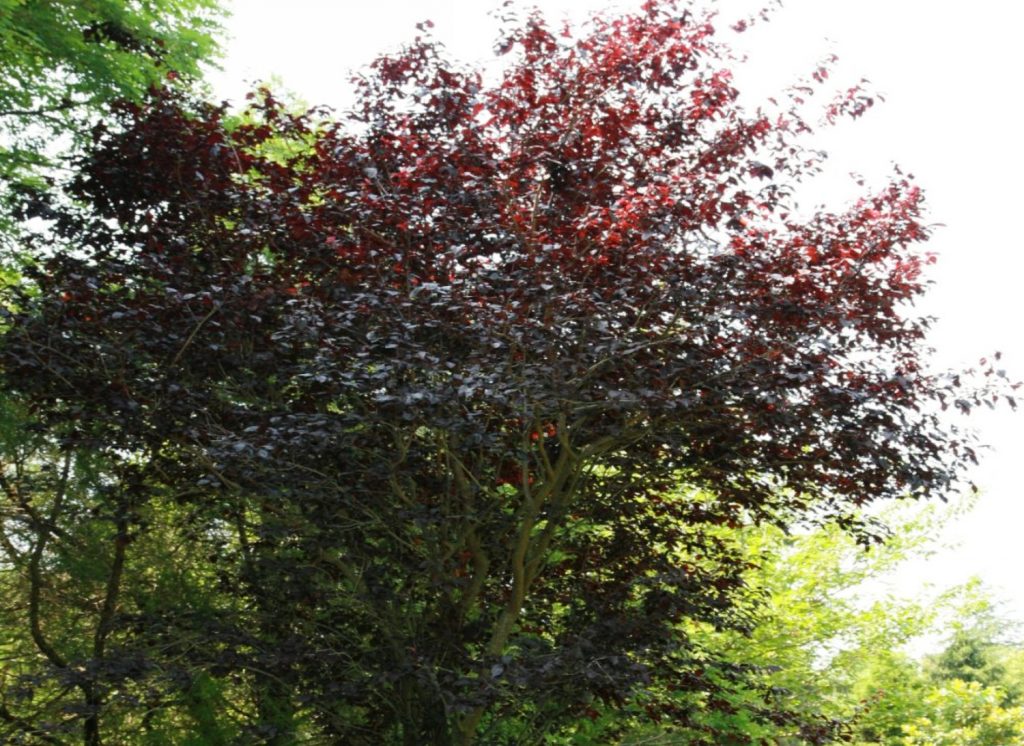
North Privet (zones 4 through 7)
Whether you have acidic or alkaline soil, loamy and moist or silty and well-drained, North Privet is capable of adapting and growing close to 3 feet a year. This semi-evergreen tree retains most of its leaves over the winter in warmer climates, so it’s perfect for growing in front of preexisting privacy fences. North Privet develops a conical shape as it matures, and maxes out at 12 feet tall with a 6-foot spread.
Wherever you choose to plant your North Privet hedge, make sure it’s in a spot where it can receive at least 4 hours of sunlight every day. Though young plants should be watered three times a week at least when first planted, North Privet has low water needs once established.
Space individual North Privet plants a foot apart to form a dense hedge to block out your neighbor’s view. If the soil is particularly wet, space plants a bit farther apart (around 2 to 3 feet) to give the roots more room to breathe.
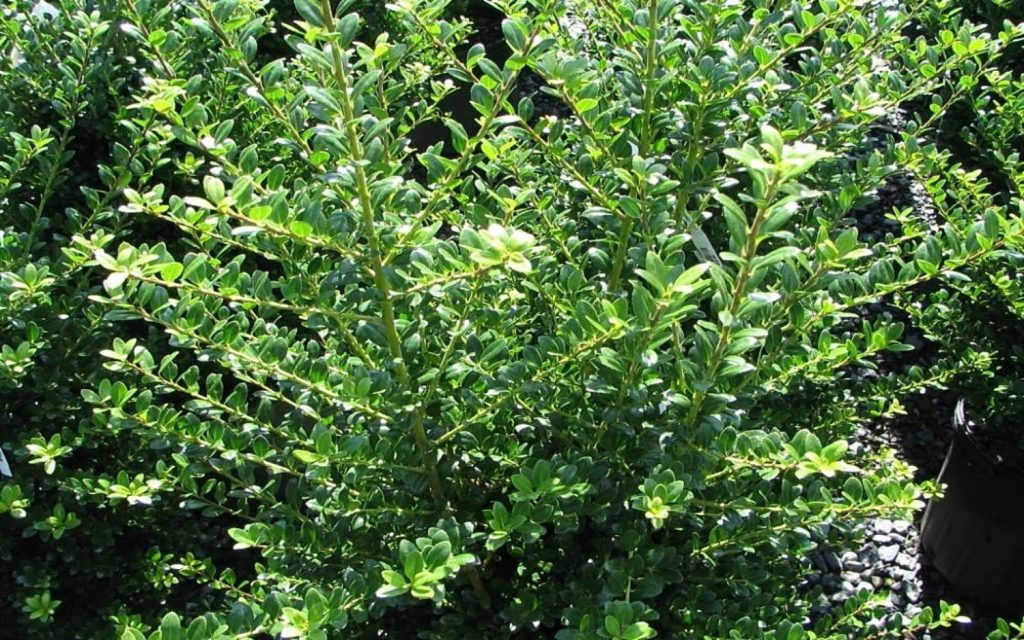
Sweet Mock-Orange (zones 4 through 8)
Also known as English Dogwood, Sweet Mock-Orange is a member of the Hydrangeaceae family. This deciduous shrub’s multitude of sweet-smelling white flowers are a hit with butterflies, hoverflies, and parasitic wasps. They’re the perfect tree for growing near berry patches and vegetable gardens to control damaging insects and improve pollination rates.
Technically Sweet Mock-Oranges aren’t trees, they’re shrubs, reaching a maximum size of 10 feet tall by 10 feet wide — just big enough to make a reliable privacy screen for your yard from spring to fall. Their cascades of blossoms in spring are replaced by kelly to forest green leaves in summer. When spaced 6 to 8 feet apart, they make a lovely privacy screen in a jiffy.
Plant your Sweet Mock-Orange trees in full to partial sunlight, in acidic to alkaline soil that drains well. You may need to amend your soil with compost to help it retain just a bit of moisture. When cared for properly, Sweet Mock-Orange trees can grow around 2 feet annually.
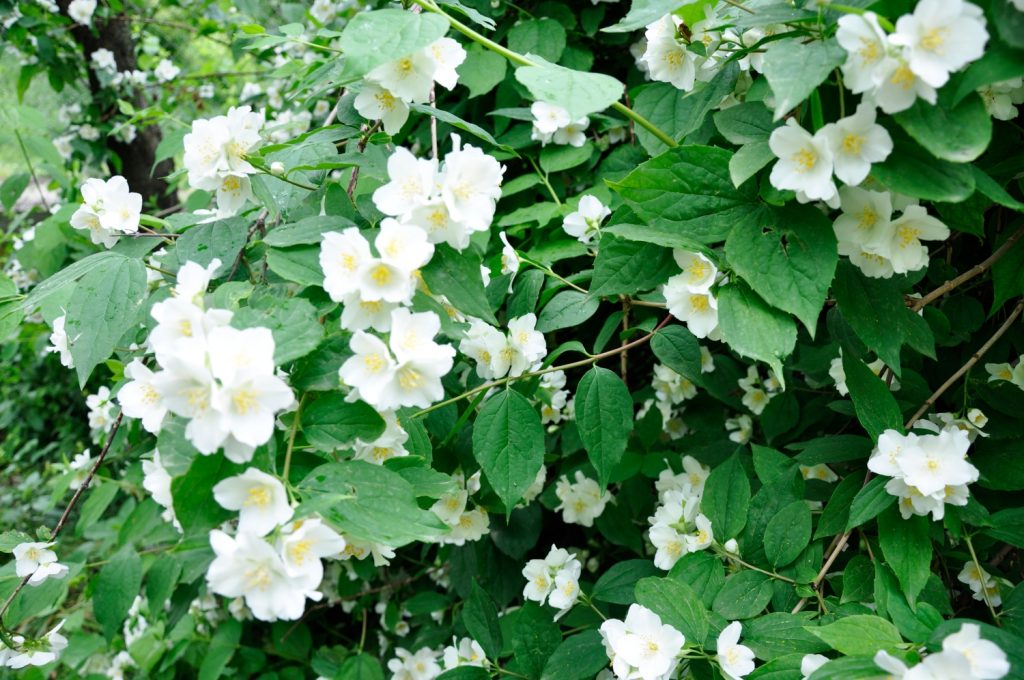
Thuja Green Giant (zones 5 through 8)
Once established, Thuja Green Giants grow 3 to 5 feet a year on average, making them a fantastic choice for your privacy screen. Young trees should be watered regularly for the first 6 months after transplanting. But, after that, Thuja Green Giants can survive on rainfall alone, although they may need supplemental watering during dry periods.
Thuja Green Giants are pest and disease-resistant. This, coupled with their drought tolerance, makes them an easy addition to any landscape. Plant your Thuja Green Giants 5 feet apart in slightly acidic to slightly alkaline soil in a location where they will receive at least 4 hours of sunlight every day. Meeting all of the plant’s growing requirements is the best way to ensure it reaches its maximum growth potential.
It’s worth mentioning that Thuja Green Giants are toxic to dogs, cats, and horses. If you’re planning on putting up a privacy fence around your barn, or if your cats and dogs like to nibble on plants, this cheap privacy tree may not be the best choice for your yard.
Nellie Stevens Holly (zones 6 through 9)
If you want privacy without the work, look to Nellie Stevens Holly. Simply plant your Nellie Stevens Holly privacy screen by spacing plants 5 to 6 feet apart, water these evergreens weekly, or whenever the soil 2 to 3 inches deep becomes dry, then stand back and be amazed as these remarkable trees grow 3 feet each year.
Nellie Stevens Holly should be planted in a location where it will receive 4 or more hours of sun a day. Plants grow best in slightly acidic soil that drains well, as they dislike sitting in water for prolonged periods. Fertilize your privacy screen in spring to improve foliage color and production.
Trees grow a maximum of 15 to 25 feet tall with an 8 to 15-foot spread. The plant’s dense foliage creeps together, sealing out the space in between and creating a lovely hedge. In fall, Nellie Stevens Holly’s bright red berries attract loads of birds, giving you ample opportunity to enjoy them from the privacy of your yard.
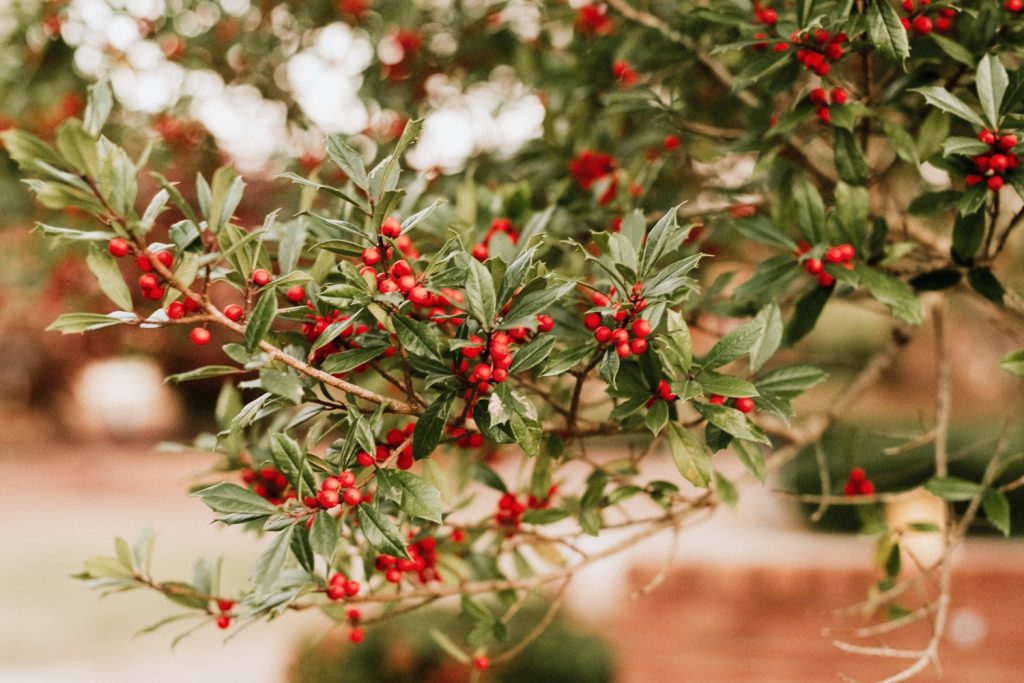
Red Maple (zones 3 through 9)
Create a barrier of flaming red foliage between you and your neighbors. Red Maple trees grow 2 to 3 feet a year on average. While these trees are incredibly drought-tolerant, they’re also very difficult to overwater. And because they’re so accepting of either extreme, they’re suitable for a variety of locations.
Red Maple trees reach 40 to 60 feet tall at maturity (usually within 15 years or so, if all of their growing requirements are met), with a 40-foot spread, providing the surrounding area with ample shade. Red Maple trees are tolerant of most soil types, from slightly acidic to slightly alkaline. These trees can survive in partial to full sunlight, and they even attract birds and squirrels when they flower and go to seed.
Even though Red Maple trees don’t mind extra water, they should still be planted in soil that drains well. Sandy loams are ideal, as they allow excess water to escape quickly, yet retain just enough moisture to keep this tree happy.
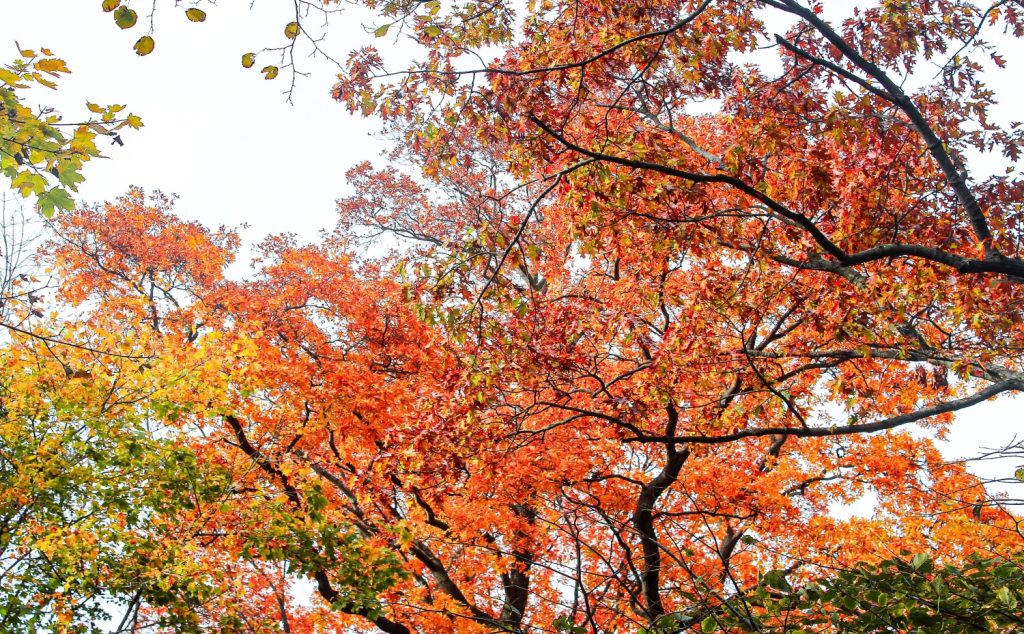
Colorado Blue Spruce (zones 1 through 7)
If you live in a particularly cold climate, Colorado Blue Spruce is probably the best privacy tree for you. These trees are cold hardy to -40 degrees Fahrenheit. But, as tolerant as they are of cold weather, Colorado Blue Spruce trees grow well in hot, humid climates, too.
The classic Christmas tree look of the Colorado Blue Spruce is hard to beat. This evergreen’s blue-green foliage is sprinkled with a silver cast, making it a perfect addition to a wintery landscape. Plant Colorado Blue Spruce 6 feet apart so the plants can pack together. This not only provides you with a barrier between your neighbor’s property, but it also gives local nuthatches and siskins shelter from the elements.
Colorado Blue spruce trees can grow to be more than 100 feet tall, and when planted alone, spread out around 30 feet wide. It’s best to plant these trees in full sun and in well-drained fertile soil. As conifers, Colorado Blue Spruce trees acidify the ground below them over time, so bear this in mind if you plan on growing other plants near your privacy screen.
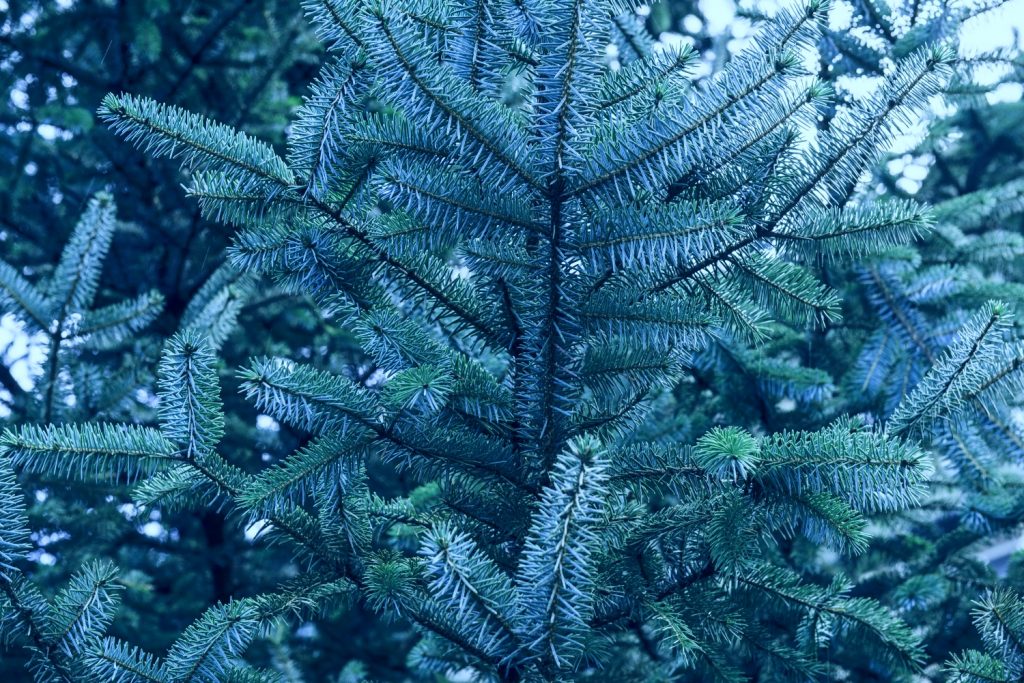
Bamboo (zones 6 through 9)
Technically, bamboo isn’t a tree. It’s a perennial flowering evergreen, a member of the grass family, Poaceae. But bamboo works incredibly well as a privacy screen because it grows lightning fast. Moso bamboo, for instance, can grow 10 feet in just three weeks’ time. If you’ve tried for years to create a privacy hedge with no luck, then give it another shot, this time with bamboo. Its invasive nature means it can quickly become established in areas where other plants just won’t work.
Like the Austree Willow Hybrid, bamboo performs best when it’s given a lot of water. These plants grow well in full to partial sunlight, and in sandy loam soils that drain well. Aside from some annual clearing out of dead foliage, bamboo requires very little attention, and, once established, will grow just fine if you simply leave it alone.
Because bamboo’s growth is so linear, it’s easy to landscape around. If you’d like to plant a flower bed in front of your privacy hedge, bamboo makes it easy. Be sure to choose the appropriate bamboo for your environment to maximize your chances of success.
Wax Myrtle (zones 7 through 10)
Wax Myrtles are native to the swamplands of North Carolina, where they thrive in water-saturated, nutrient-poor soils. This tree’s tolerance of salty ground and air pollution makes it a popular choice in southern landscapes. Wax Myrtles are tolerant of occasional flooding and periodic droughts. Their ability to thrive in both extremes makes them a great choice for spaces where other plants have failed to thrive.
Though Wax Myrtles may lose their olive-green leaves after a cold snap (a normal reaction for the plant), they tend to stay green year-round. This plant can reach 20 to 25 feet tall, making it more of a tall shrub than a tree. When plants are spaced 3 feet apart, they create a thick privacy hedge in a matter of just a few seasons.
Wax Myrtles are tolerant of full sun to partial shade. Plants grow 3 to 5 feet per year and require very little care. The flowers and fruits of female plants attract butterflies and songbirds, making your fast growing, inexpensive privacy hedge a refuge for local wildlife.
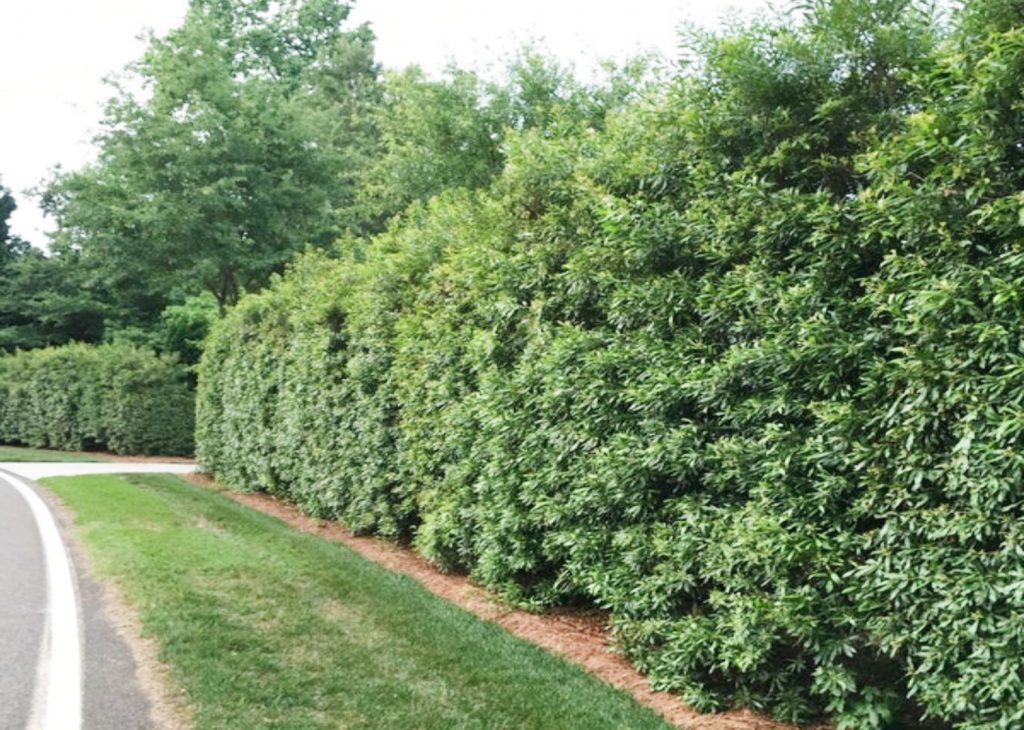
Leyland Cypress (zones 6 through 10)
The Leyland Cypress is an evergreen that reaches 40 to 60 feet tall by 20 to 25 feet wide. Trees grow 3 to 5 feet per year when planted in full sun and well-draining sandy loam soils. When it comes to privacy screens, especially in urban areas with little space in between homes, this tree is a tough one to top.
Leyland Cypress trees have fluffy, feathery foliage and a conical growth pattern that’s easy to maintain. A bit of pruning each year is all that’s needed to achieve a manicured look. Plants can be spaced 6 feet apart to maintain their Christmas tree-like appearance or packed together tightly at 3 to 4-foot intervals to make a hedge.
Young Leyland Cypress trees require regular watering to become established. Insufficient water intake is one of the leading causes of transplant shock, so check the soil regularly and water the plants whenever it feels dry. Mature plants are drought-tolerant, however, and are usually satisfied with rainfall alone.
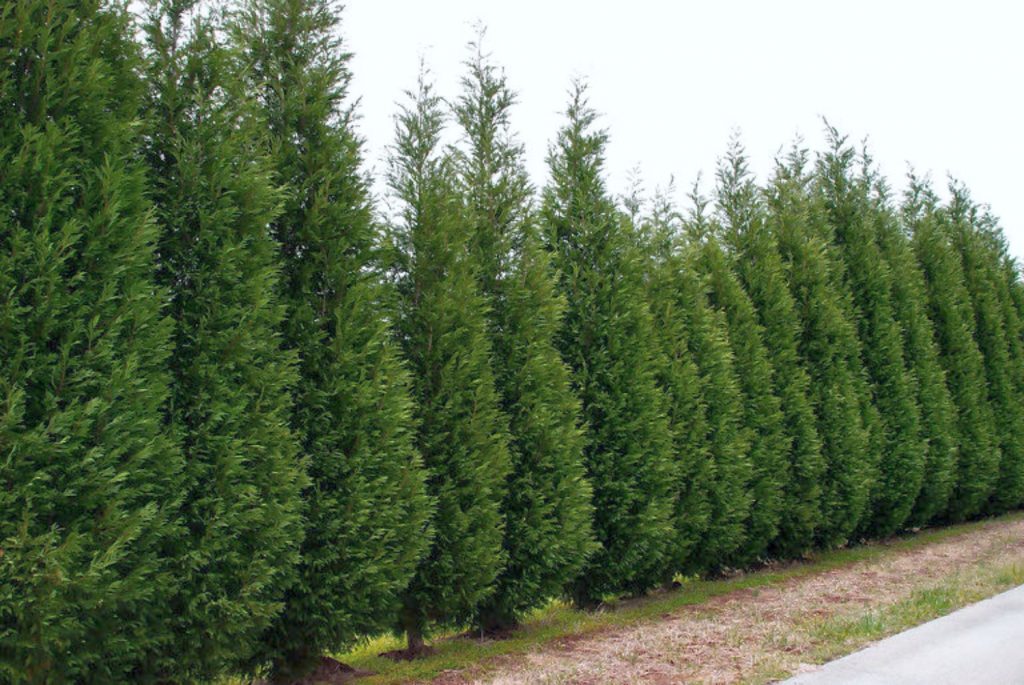
Loblolly Pine (zones 6 through 9)
If your property has sandy soil and if it sees periods of flooding followed by extreme droughts, the Loblolly Pine has what it takes to withstand all of these unforgiving conditions. Plant Loblollies in full to partial sunlight, and space the trees 14 feet apart to allow them to fill in. Loblollies grow best when made to compete with each other, and can rapidly reach 60 to 90 feet, growing upwards of 2 feet per year.
Loblolly pine trees are native to many southern forests and provide turkeys, chickadees, nuthatches, squirrels, and barred owls with an ideal home. Using these trees to create a barrier between your property and your neighbors won’t just give you the privacy you crave, but it will also give these animals the shelter they need to survive.
Be sure to water young trees regularly during the first year, even in winter. Evergreens require more moisture than deciduous trees during the cold months since they retain their foliage. As with Colorado Blue Spruce trees, Loblolly pines acidify the soil over time. So test the soil before landscaping around them.
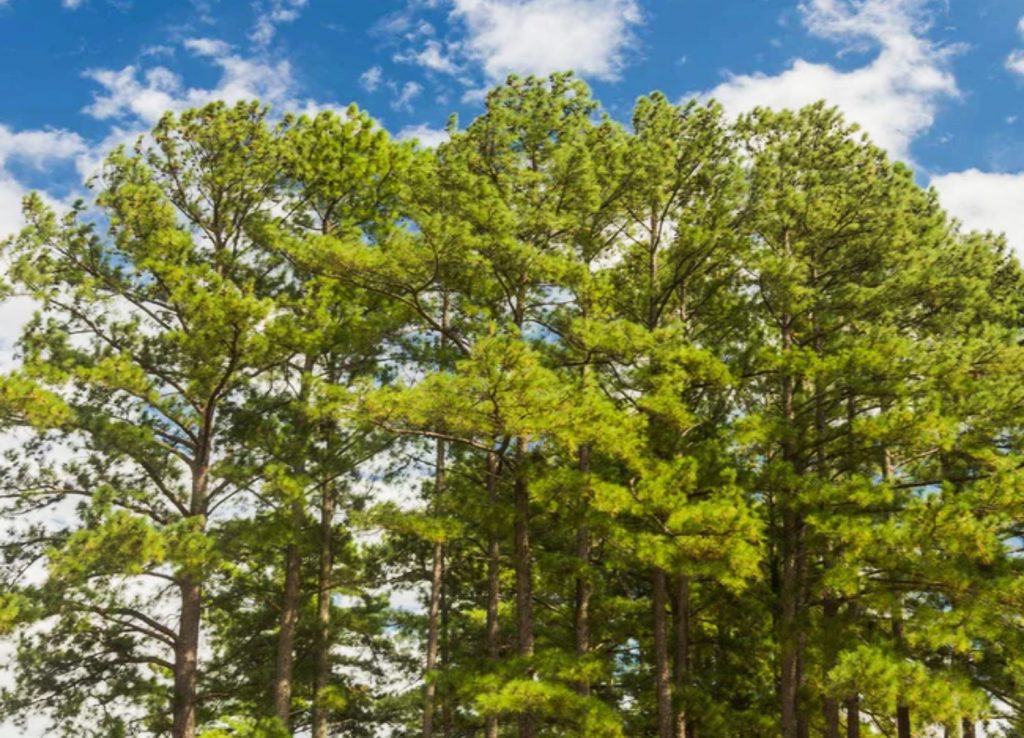
Benefits of planting privacy trees
In addition to the obvious benefits, including securing your own personal privacy and providing shelter for local wildlife, privacy trees give your home protection from the elements and slows soil erosion. Planting a privacy hedge adds to your home’s property value, and is much easier to care for than a wooden privacy fence, which requires maintenance and repairs over the years.
A living privacy fence is an investment, but with the help of these cheap fast growing trees, you can turn your garden into a secluded paradise.
